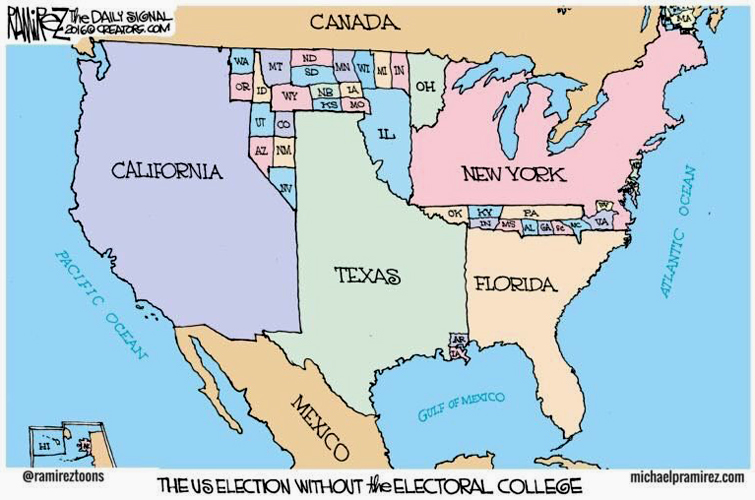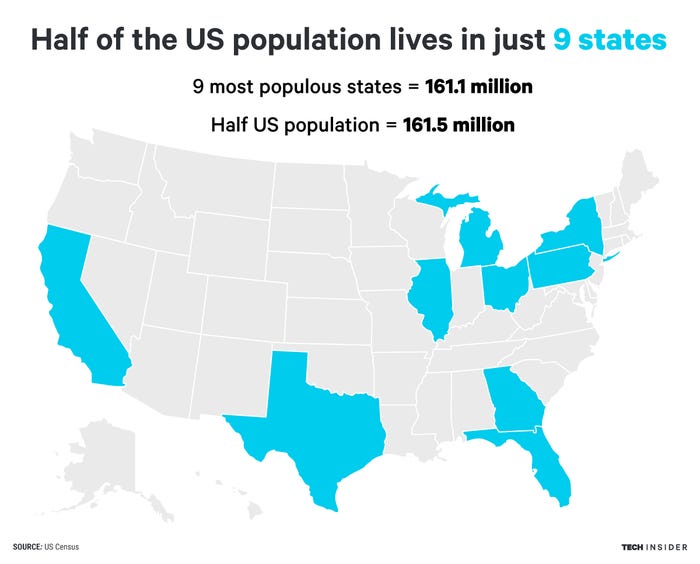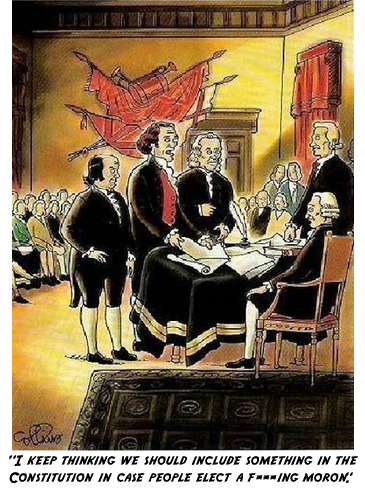Originally published February 14, 2017
Data update 10-10-2019
Minor updates 11-02-2020

written by Net Advisor™
WASHINGTON DC. The popular vote still seems to be a popular idea for national elections. Some have argued (especially after losing an election) that the Electoral College should be banned and we should use the popular vote.
U.S. National Elections are decided by the Electoral College, thus the popular vote does not mean anything constitutionally or legally speaking.
At first, and without much thought, I thought the popular vote in national elections seemed to be a logical idea. However, when one actually studies why the popular vote is not really a good idea in national elections, and why we have an Electoral College, the rational starts making more sense.
If the U.S. had a popular vote for president, which is the aspect of a true or a pure Democracy, that could actually provide advantage for voters in states with high populations. This would also place a disadvantage to voters in states with smaller populations. Thus, under a Democracy, high populated states would have a bigger say in government, and less-populated states could have their vote effectively silenced.
[1] How the Electoral College Came to Be.
The Electoral College was originally written in the U.S. Constitution under Article II.
An Amendment to the U.S. Constitution was initiated in 1803 and passed by both the U.S. House of Representatives and the U.S. Senate. The Amendment was then ratified by 3/4ths (75%) by State Legislators which became the Twelfth Amendment in 1804.
So now we know the Electoral College has been around for over 200 years.
Our forefathers clearly had a keen vision that America’s population was not going to be evenly distributed. As a result, they needed to have a Constitutional Amendment protecting less-populated states from being over-ran by greater populated states.
“Using the latest US Census data, we determined that just nine states — California, Texas, Illinois, Michigan, Ohio, Pennsylvania, New York, Georgia and Florida — account for half of the entire US population.”
— Business Insider

[2] Risks to The Republic: A Pure Democracy.
In 1787, Constitutional Forefather, James Madison did not think the U.S. should have political parties but knew that people are self-serving and some would pursue power in government and implement interests that may not be for the common good.
Madison was against the idea of a pure Democracy.
“…a pure democracy, by which I mean a society consisting of a small number of citizens, who assemble and administer the government in person, can admit of no cure for the mischiefs of faction…
…Hence it is that such democracies have ever been spectacles of turbulence and contention; have ever been found incompatible with personal security or the rights of property; and have in general been as short in their lives as they have been violent in their deaths.”
— James Madison wrote in Federalist 10, Nov. 3, 1787.
Madison was concerned about the risk of (political) “factions.” Populous states or like-interest states could then join together (legislatively) for mutual interests; and would eventually seek to control government in this form of a (popular vote) through a “Democracy.”
These factions would then act as “mischiefs,” suppressing rights and liberties including legislative representation from those who did not share their same (political or other) interests.
We see examples of what this type of Social Democracy looks like. Groups of similar or like-interested parties gather in the streets protesting one thing or another, sometimes using violence and threats to try and sway others that their “popular” opinion should rule above anyone else.
The truth is these ideas are not popular, rather are created by organized factions who want to push public discourse “by any means necessary.”
Some in the media seem to be encouraging the protests, and even went so far to provide locations where to go. The media’s job is not to act like an Anti-government propaganda outlet, but supposedly to represent the five core ethics of journalism.
Losing self-control seems to be the norm. ‘The louder I scream, the more attention I will get,’ seems to be the mantra. Even this New York University professor shared her meltdown rhetoric in this (uncensored) video.
[Video since deleted by YouTube, parent company of Google aka Alphabet, Inc.]
Traditionally, professors are supposed to have a standard of ethics, but apparently if something gets labeled controversial by a ‘faction,’ the debate is over and canceled?
So we have a difference between popular debate and those who want to shutdown debate altogether – or else here’s the riot? (PDF w more images).
This is why the U.S. is not a Democracy where mobs rule. The few hundred, thousands or even millions of like-minded people are not sufficient to sway the tens of millions more who are not protesting or the similar.
The Electrical College is designed to protect citizens in all U.S. states and those who are not being heard.
[3] USA Not a Democracy.
The United States is not, nor did it ever intend to become a Democracy; but rather a Constitutional Republic. This Constitutional Republic allowed all states, including the less populated states to have a Representative say in the Electorate.
As we know, the high populated states (such as California, Texas, New York, Florida, Pennsylvania, and Illinois) do get more representatives in the Electoral College than the less populated states, but all states are still entitled to their representative say in government.
As it turns out today, those six high-populated states carry 161 electoral votes, or about 60 percent of the 270 votes needed to win the U.S. Presidency. Because of its record population compared to other states, California has the voting power greater than 15 U.S. states combined.

In Federalist No. 10, James Madison argued that a Republican form of government would be more beneficial, and such was further discussed in Federalist No. 39. This does not mean that everyone should be Republicans, only that the style of government should model representatives of the population which is the type of government we have the U.S. – a Constitutional Republic.
[4] Foreign Political Influence & Succession.
Alexander Hamilton cautioned about foreign intervention (non-citizens?) gaining influence in the USA, and who may attempt to create their own union (or state, or push for secession?).
“…most deadly adversaries of republican government might naturally have been expected to make their approaches from more than one querter, but chiefly from the desire in foreign powers to gain an improper ascendant in our councils. How could they better gratify this, than by raising a creature of their own to the chief magistracy of the Union?”
— Alexander Hamilton wrote in Federalist No. 68, Mar. 14, 1788.
Such secession action would negatively impact the other states as Abraham Lincoln wrote in the 1860’s:
- Lincoln: We are friends (Mar. 4, 1861).
- Lincoln: Secession Will Destroy Democracy (Feb. 11, 1861).
- Lincoln: Physically We Can Not Separate (Mar. 4, 1861).
- Lincoln: Secession Equals Anarchy (Mar. 4, 1861).
- Lincoln: Secession is Unlawful (Mar. 4, 1861).
Secession didn’t work out at all in the 1860’s, and eventually led to The Civil War.
[5] Constitutional History: The Amendment Process.
The U.S. Constitution was written in such a way that a small or even popular ‘factions’ could not easily change it. There is a legal process to Amend the U.S. Constitution.
The original 10 Amendments were written into the Constitution at a single time called the Bill of Rights.
Over the last 225 years (from 1789 to 2014), there have been about 11,623 attempts to Amend the U.S. Constitution, with only 17 successes.
To Amend the U.S. Constitution comes under the provision of Article V of the U.S. Constitution.
A Constitutional Convention must be called, and there are limitations on what can be Amended. The Amendment bill must pass BOTH the U.S. House and U.S. Senate by 2/3rds majority vote (66% each). This Constitutional requirement also overrides any veto opposition from a sitting U.S. President.
To try and stop or slow a Totalitarian/ Dictatorship/ Theocracy, or a Popular Democracy over the U.S. Government, a super 3/4ths (75%) majority, of state legislators must also agree to the Constitutional Amendment or the Amendment dies (thus never happens).
Getting the federal government to agree on anything is a tough job. Getting most all the states to agree with the federal government too is even tougher.
So the framers of the U.S. Constitution didn’t want a single party who potentially could control the federal government (U.S. House and U.S. Senate) to have total power to change (Amend) the Constitution.
America would probably have never made it thus far if the Constitution could be changed with simple control in the federal government’s executive and legislative branches.
I would argue if Amending the Constitution was easy, at some-point, the U.S. would have swung to some radical political Left (such as Socialism, Marxism, and Communism); and or politically Right (such as a Theocracy or a Capitalist government).
These governments would challenge the Constitution as it was originally intended, and would create undue stress on a nation including massive currency instability, high inflation risk, and make capital formation for businesses unpredictable. Ultimately, this economic Yo-Yo would create high uncertainty leading to a collapse a nation’s economy and its political system.
Amendments.
The two most recent Amendments include the 26th. This prohibits government from blocking U.S. citizens, 18 years or older from voting.
The 27th Amendment that restricts Congress’ pay from increasing or decreasing until the next term, was first introduced in 1789, but not ratified until some 202 years later (1992).
With a few exceptions, most Constitutional Amendments are short and to the point. Anything too long and too wordy can be subject to greater interpretation, and thus become weak. Despite the simplistic, to the point language, some (Anti-Americans) still attack the key Amendments, primarily the 1st and 2nd.
[6] Summary.
What we’ve found is that the popular vote may be a popular idea for national elections. The notion of a popular vote in national elections runs the risk of minority ‘factions;’ where high populated states or collective groups with similar interests could ban together to silence lessor populated states or other opposition from government representation.
Our Constitutional forefathers contemplated potential risks of a Pure Democracy (popular vote rule) in Federalist 10, 39, and 68.
The purpose of the Electoral College is really to protect the rights and interests of ALL U.S. citizens, in ALL U.S. states, not just the highly populated states.
The United States is not a Democracy, but rather a Constitutional Republic.
Alexander Hamilton cautioned about foreign intervention gaining influence in the USA, and who may attempt to create their own union (or state, or push for secession?). Abraham Lincoln said that secession would be destructive to the Union, was about anarchy, and is unlawful.
The U.S. Constitution was written in such a way that a small or even popular ‘factions’ could not easily change it. To change anything in the Constitution would require a Constitutional Amendment.
An Amendment bill must pass BOTH the U.S. House and U.S. Senate by 2/3rds majority vote (66% each). Such a vote then automatically overrides any veto opposition from a sitting U.S. President. Then, the Amendment must be ratified by 3/4ths majority vote (75%) of state legislators (ie: 38 of the 50 U.S. states must agree to the Amendment) or the Amendment dies.
While many may still desire to have a popular vote in national elections, the representative approach has worked for over 200 years.
Cartoon at page top by Michael Ramirez, copyright by their respective owners. Unable to name source 2nd cartoon (mid page), and was edited for language. Please advise us owner’s name for credit. Population graphic, copyright 2016 by Business Insider.
Original content copyright © 2017 NetAdvisor.org® All Rights Reserved.
NetAdvisor.org® is a non-profit organization providing public education and analysis primarily on the U.S. financial markets, personal finance and analysis with a transparent look into U.S. public policy. We also perform and report on financial investigations to help protect the public interest. Read More.

